
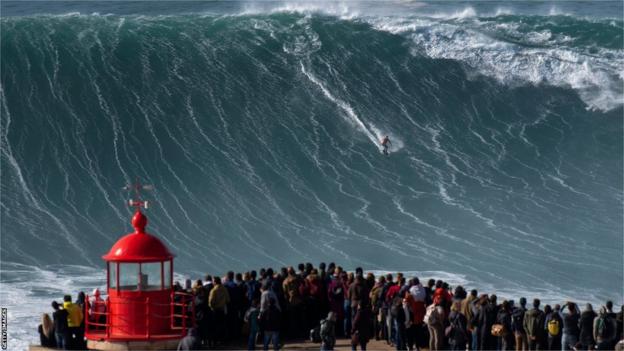
As he looks out from his balcony, over slumped, drying wetsuits, Andrew Cotton can see it all.
The stretch of sand, the salt haze, a spike of cliff and a scarlet lighthouse.
Most of all, Cotton can see Nazare’s waves. They are small today, relatively at least, but there is still a backdrop of bubbling white water and churning white noise.
When the swell is right and the surf is up, it is a different story on a different scale.
Nazare, a small town 60 miles north of Lisbon, is where towering waves – some the height of 10-storey buildings – crash to shore.
For generations of local fishermen, those conditions have meant danger and death. For Cotton they are a way of life and a living.
“Weirdly, somehow, I have turned it into a job, so when it is big, you go out there,” he says.
“You go out there all day and do what you need to do.”
When it is one of those days, Cotton doesn’t need to even look. When the biggest, most lucrative wave in the world arrives, he knows as soon as he wakes, before his eyes open.
“Living here, I know how big the waves are by how much the windows are rattling,” he adds.
“It can really be something else, you know? The ocean can be scary when there are no waves. When here is big… it can be petrifying.”
Nazare’s wave has several beginnings.
One is 130 miles out, three miles down and millions of years back in the quiet cold of the Atlantic.
From there a deep, underwater canyon formed, snaking into the Portuguese coast. It climbs steeply just off the shore at Nazare and, when the conditions align, it funnels a mass of water up into freakish moving mountains.
Another is 14 September 1152. That day legend says a local hunter was saved from falling over a cliff edge and into the wild ocean below by a holy vision, forever linking Nazare with heaven, hell and high water in the Portuguese imagination.
For Cotton and other big-wave surfers the beginning of Nazare’s waves is more modern and less dramatic. It was an email sent by Dino Casemiro in 2005.
As a child, Casemiro, the son of a fisherman, would steal box lids as local women packed the catch and use them to catch waves instead.
“They told me that I will die,” he says of his family’s reaction to his taking his makeshift bodyboard to Praia do Norte, the beach where the biggest waves break.
“They saw the waves like a devil. In Nazare we have a relationship of love and hate with the ocean. Love because it gives us the food and the tourists and hate because it also takes the lives of our relatives.”
Casemiro persevered, but some days the waves and the doubts were too big.
“We would sit on the sand looking at perfect, massive waves with no-one on them because we didn’t have the confidence, skill and equipment to ride them,” he adds.
However, Casemiro knew some people who might.
Tow-in surfing, where surfers take turns to drag each other on to waves via a jet-ski, had been pioneered in Hawaii a decade before, allowing the brave to ride otherwise unreachable, fast-moving monsters.
When his local wave was at its wildest, Casemiro took a picture, plugged his camera into his computer and went surfing online instead.
“I searched for the most-known surfers in tow and big-wave surfing, but it was 2005,” says Casemiro.
“Now everyone has Instagram and Facebook. Then it wasn’t easy, but Garrett already had his own website and in the corner was a ‘contact me’ button.”
A female voice crackles over the radio.
“You have three giant waves coming.”
The jet ski, driven by Cotton, peels away and up the steepening face of the wave. The surf board, ridden by Garrett McNamara, heads in the opposite direction; down past the point of no return.
The angle isn’t perfect.
“I wanted to be a lot deeper entering that wave,” says McNamara.
“I was holding that rope until the last second. It made me go all the way to the bottom of the wave, turning off as hard as I could.
“As I looked back out to sea, the whole horizon had gone black.”
It was 1 November 2011; six years after Casemiro’s first email to McNamara, one year since McNamara stood on Nazare’s lighthouse, declaring he had found his Holy Grail and 15 seconds into the biggest wave ever surfed.
The footage is both absorbing and disorientating.
McNamara hurtles downwards, but only seems to creep towards the wave’s bottom, as it swells almost as fast as he can ride it.
He is being carried towards the camera, but the perspective is out of sync. McNamara appears to shrink, rather than grow, as the crest surges skywards behind him.
And all the time, tonnes of water teeter over him, hanging only by the thin, white thread weaved by his board down the face of the wave.
“You don’t hear the wave,” adds McNamara. “You are going so fast all you can hear is the wind rushing past your ears.
“You are not really thinking either. You are in the flow state, following your heart.
“It’s exhilarating. It is like driving a car under an avalanche, but you are taunting the avalanche rather than trying to get away from it.”
As the spray settled, the ripples from his feat travelled fast.
A couple of days later, surfing legend Kelly Slater tweeted to describe what he had been forwarded.
“I just saw a shot of Garrett McNamara from Portugal on a stupidly big wave. He should post that thing ASAP.”
A week later, he did. The footage was first released to ESPN, giving a primetime United States audience first sight of their fellow American. By the next morning, it led bulletins in Portugal and soon, it was everywhere.
“It went bonkers,” remembers McNamara. “Bananas! The media storm we had to endure after the ride was far bigger than the wave.”
The wave was clocked at 78 feet (24 metres) high, a world record. As interview requests came from round the globe, McNamara spent the next three weeks repeating his story, and that of Nazare’s waves, to television presenters, radio hosts and newspaper reporters.
It was a triumph for him, but also for a unique bit of town planning.
Casemiro’s hunch that Nazare’s waters could deliver more than fish and summer tourists had found support in city hall.
“We didn’t have a huge budget and we realised that doing something with big waves will save us 20 to 30 years of promotion,” explains Pedro Pisco, part of a small municipal team, alongside Casemiro, who banked on conquering Praia do Norte’s waves.
Together they recruited the small band of surfers, supplied equipment and came up with a strategy to sell their small town to the world.
The rest of Nazare had thought it a bad bet.
“At the beginning, nobody believed in us. Not one person,” says Casemiro.
“It was really tough. Everyone mocked us. They said we were wasting our time on Praia do Norte. No sponsors believed in us.”
Initially, after McNamara’s arrival in Nazare, the sceptics had seemed right too.
The jet-skis were underpowered. Their engines would flood or choke out on stray plastic bags, leaving rider and surfer bobbing perilously in the path of oncoming waves.
Even when they were working, Englishman Cotton admits he, as driver, was under-skilled.
“I wasn’t up to scratch, I just blagged it really,” he says of his turns in control of the motor.
The day before the world record had been another failure; a broken jet-ski and an injury for Cotton.
They weren’t even going to venture out the following morning. But then conditions changed, McNamara, Cotton and their Northern Irish team-mate Al Mennie changed their mind and, together, they caught the wave that changed everything.
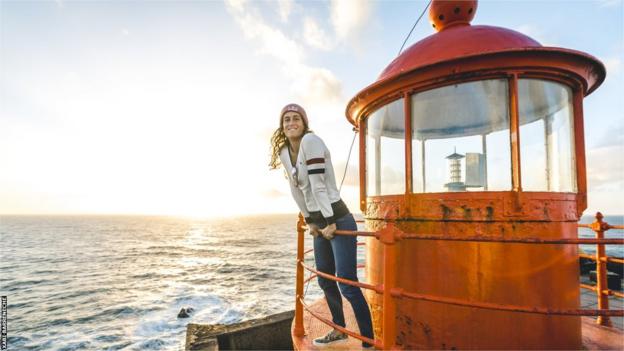
“When you let go of the rope, there is a feeling of being alone,” says Justine Dupont.
“The wave is still forming right under your feet, coming up from the ocean floor. It is like you are going up in a lift.
“Then you are going faster and faster and you feel like you are using 100% of all your senses and your potential as a human, like you are activating your superhero mode.
“You are just living the moment, nothing else exists apart from that moment.”
Dupont had seen video of McNamara’s world record wave. She had seen the viral photo of another terrifying break he had ridden a little over a year later.
But, when she first arrived in Nazare in 2016 with her partner, fellow surfer and sometime jet-ski driver Fred David, those images intimidated as much as inspired.
“I was super nervous and impressed by the footage,” she says.
“We went in the water, the waves weren’t that big and Fred told me, ‘come on, if you are scared of this size, we are going to have trouble staying here!’
“But I managed to win against my fear.”
She has done more than that. Dupont, 31, is now one of the best big-wave surfers anywhere. Few of Nazare’s waves have been ridden as well, or captured as thrillingly, as one she caught in February 2020.
But the fear remains. It has to. The danger is too clear, the reminders too recent.
In January this year, luck ran out. Brazilian Marcio Freire, a 47-year-old veteran of the big-wave world, became the first surfer to die on Praia do Norte.
Dupont is reconciled to that risk. She recognises that every time she enters the water, she may not return.
“It is crazy, you feel so free on the wave when everything is good, you feel super alive, but when something goes wrong you think, ‘OK, I may die’,” she says.
“There is a little moment where you question what is going to happen.
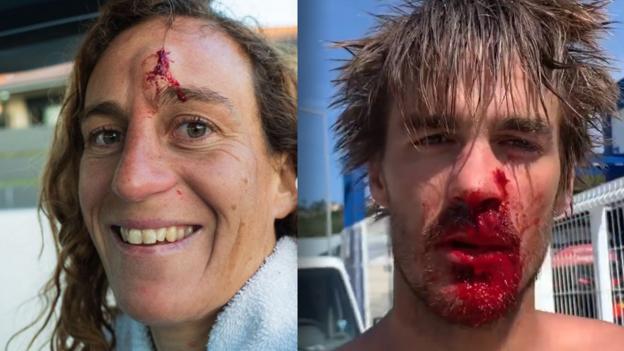
“There is a suspense about how the wave will hit you, and then, under the water, it is super violent.
“You have to be comfortable with the good things you have done in life.”
Cotton’s outlook is a similar mix of faith and fatalism, tested by experience.
In 2017, he was towed on to a wave by McNamara, misjudged a line slightly and was spat out. His body was tossed 20 feet out of the breaking wave and into the air. When he landed back on the water’s surface, the impact broke his back. He returned to surfing in Nazare within a year.
“You can’t play it safe, there is no point in going out there with that mindset,” he says.
“The wipeouts and falls hurt, but they are part of it. You can’t blow the whistle or call time-out out there, the waves don’t stop.
“You either learn to enjoy it or just don’t do it.
“At some points you think, this could be it, but one good skill I have is I can switch off. In that situation, I think about absolutely nothing, almost resign myself to being dead.
“When you do that it is amazing how much the body can take, how long you can hold your breath for, how powerful the mind is.
“But as soon as you panic and your heartbeat goes high, that 30 seconds underwater can feel like a minute. It gets dangerous.”
In a sport that is usually solitary, those stakes strain the partnership between surfer and driver.
“When the waves get that big, it is a team sport. Everyone has to be a player and it has to be less about you, more about the team,” says Cotton.
“You might be having the best surf but then you jump on the jet-ski and you can’t get your mate any waves. It can be frustrating, you can have arguments, sometimes you leave feeling guilty.
“It can be like a marriage, you have ups and downs and good days and bad days.”
For Dupont, the parallels between personal and the professional are apt.
“It is tricky as a couple for sure,” she says of working alongside her partner.
“I know he is going to do his best for me, but we got to a point when we felt the risk and Fred had a hard time putting me on a big, big wave.
“So during the big days now, I have started working with [Brazilian surfer] Lucas Chumbo. I respect him and I don’t argue with him. With Fred, I respect him, but sometimes I need to speak!
“At the start in Nazare it was good because Fred and I could surf a lot and improve fast. But when you are on the line-up on big days, in stormy conditions, you really feel the risks. You think ‘what are we doing here, this isn’t smart, we should go back home, we love each other and we have a good life’.”
If putting your partner in harm’s way is hard, being out of town and out the loop is perhaps worse.
On big days at Nazare, Fred is still there in the water. Only now he works on the safety jet-ski, tasked with recovering Dupont at the end of her ride, rather than launching her on to it.
McNamara’s wife Nicole has made a similar choice, getting involved, rather than attempting to ignore the risk.
Standing on the lighthouse, she spotted the fateful world record wave in 2011 on the horizon and radioed it in for McNamara, Cotton and Mennie to line up.
A year later, she and Garrett were married in a ceremony on the same spot. The second of their three children bears Nazare as a middle name.
The town is part of the fabric of their family life. It has been a defining staging post in Dupont and Cotton’s careers. But all three have made Nazare’s name, just as much as Nazare has made theirs.
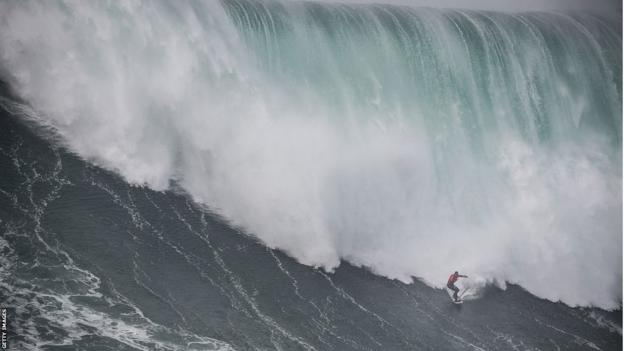
The local paper – Regiao da Nazare – didn’t give McNamara’s arrival much space back in December 2010.
A story covering the Hawaiian’s press conference, alongside Nazare’s then-mayor Jorge Barroso, took up barely a third of page 12.
Much more prominent, less than four months before, was a special report headlined “Professions on the verge of extinction”.
Below, was a picture of Jose Manuel Rebelo, a basket weaver. Cobbler Jose Maria Eusebio clutched a pair of sandals in another image. Dressmaker Ana Emilia Amada Curado Louracio looking up into the lens from her sewing machine.
The article lamented the decline of traditional industries in a town of terracotta roofs and polished cobbles. It guessed fearfully at what the future might hold.
It never foresaw what a big swell now brings to Nazare.
Food trucks and merchandise hawkers line the road down to the lighthouse as busloads of people, mostly young, scramble for a vantage point.
Thousands line the cliffs and video drones hum through the air as jet-skis and surfers take on mammoth sets of waves below.
Nazare is, after some initial opposition from the other side of the Atlantic, indisputably the biggest wave in the world.
The world record for the biggest wave surfed has been broken twice since McNamara in 2011, both occasions were in Nazare.
Germany’s Sebastian Steudtner is the current holder after a wave he rode in October 2020 was officially measured at 86 feet (26 metres).
France’s Dupont and Brazilian Maya Gabeira have fought over the women’s best mark, but whoever owns it, it too belongs to Nazare.
As well as being the world biggest wave, Nazare is also one of the most accessible.
Cortes Bank – one of Nazare’s nearest rivals – breaks 100 miles off the Californian coast and comes alive only for a few days a year.
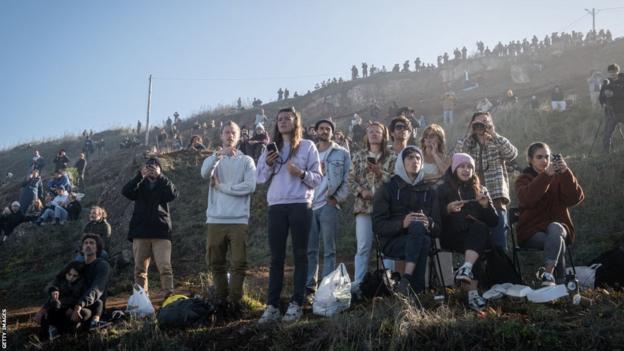
By contrast, Nazare is a 90-minute drive from an international airport and breaks so close to the shore spectators above can hear the surfers’ shouts below in an almost stadium-like setting.
The lighthouse, which once warned fisherman away from the rocks, is a fixture in mesmerising online footage, luring people to Nazare.
It now houses a surfing museum, with tickets costing two euros each. It welcomed 371,391 visitors last year, almost five times the number who attended in 2015, its first full year of opening.
One report claimed the number of tourists to the town had trebled in the decade since 2010.
Estate agents windows gleam with market-fresh properties and promises they can do business in a number of languages.
“It is crazy,” says Dupont. She and her partner now live a 15-minute drive inland in a quiet, pine-shaded home, away from Nazare’s bustle.
“In 2016, we could drive to the lighthouse and there might be two people there. Now there are so many people, the road is closed, there is almost no access for us surfers to check the wave.
“I used to go with my sponsors beanie, now I kind of hide it because I don’t want people to stop me and ask 100 questions.
“They are super nice but it has changed a lot – and for good I think.”
The influx has certainly brought more money to the town. Businesses that previously survived from summer to summer, now continue to cash in through the winter’s big-wave season.
Some locals don’t see the same benefits. Nazare’s cobblers, dressmakers and basket-weavers won’t find many sales among the surf crowd.
Like on shore, the dividends for those in the water are shared unevenly.
There are a few big-wave surfing competitions. Dupont picked up $9000 (£7,300) cheque for the best female performance at Nazare’s biggest last year, but sponsors provide the real windfall.
Before 2011, McNamara was backed by some low-key Brazilian surf equipment manufacturers. “None of the cool companies,” as he puts it.
After Nazare’s carefully-coordinated publicity blitz for his world record, blue-chip brands got on McNamara’s board by the boat-load.
In addition to a raft of new surf sponsors, he has represented a high-end German car company, a Swiss watchmaker and a Swedish bike rack manufacturer.
Such endorsements depend on exposure and getting it involves playing the game as well as pursuing your sport.
“There are so many big waves ridden each year,” explains Cotton. “You get the biggest swell of the year and the media make out there is only one wave in it. One person gets chosen and it not always the right person or the right wave.
“It can be about a brand marketing their athlete or an agency getting their photos out… that is it.”
Measuring surging, moving waves is an inexact and time-consuming science. Steudtner’s world record wave was only officially measured and ratified 18 months after he had surfed it.
Hype fills the gap.
“Two or three times a year, there will be press releases,” says Cotton.
“I read one recently saying a 115-foot wave had been surfed here. Another said a 101-foot wave. Another was 98 foot. People just make up numbers, get a scientist to say something and you know what? It is great for big-wave surfing, the town, and the sport.”
In this big-wave boom town, the stats may not always be what they seem.
But the stakes and the surf dwarf everywhere else.
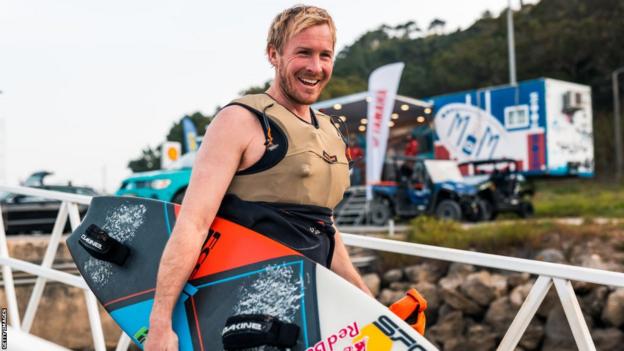









More Stories
Kerr’s skill ‘made the boys cry’
Tufnell predicts Australia win on final day of Ashes
No hope of survivors from MRH-90 helicopter crash in Australia